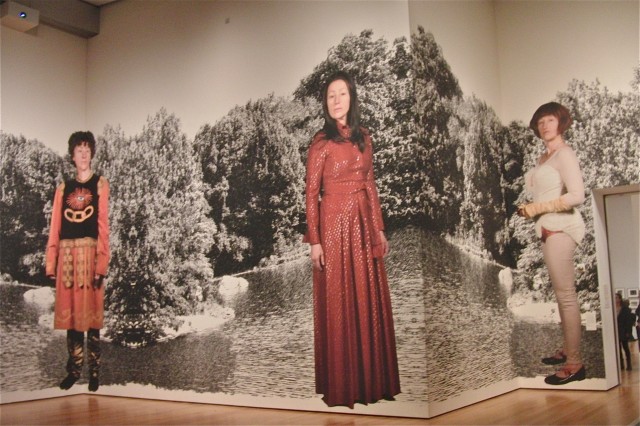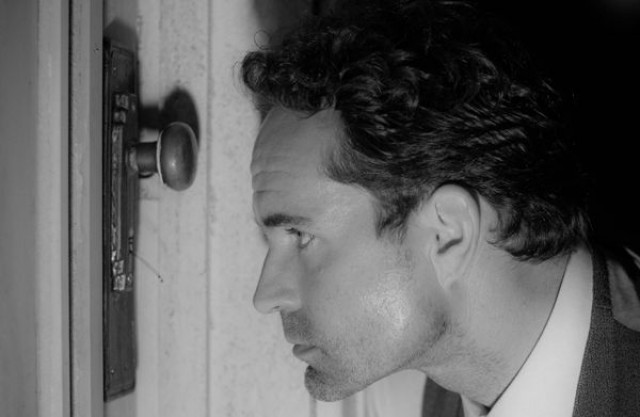
Will Ryman’s “Everyman” wraps around gallery space and lets visitors walk inside his head (photo by twi-ny/mdr)
Paul Kasmin Gallery
293 Tenth Ave. at 27th St. and 515 West 27th St.
Tuesday – Saturday through March 24, free, 10:00 am – 6:00 pm
212-563-4474
www.paulkasmingallery.com
anyone and no one slideshow
Will Ryman keeps growing as an artist, both literally and figuratively. Since 2003, the former playwright and student of Absurdist philosophy has been creating such fantastical characters and installations as “The Dog Walker,” “The Bed,” and, perhaps most famously, “The Pit,” containing figures made of papier-mâché, PVC tubing, wire mesh, and acrylic paint, amassing a rogues’ gallery of engaging creatures with oddly shaped heads. He’s also constructed giant roses out of fiberglass and stainless steel that first filled the Marlborough Gallery for “A New Beginning” in 2009, then reached new heights for “The Roses” along Park Ave. last year. For his first exhibition at Paul Kasmin, the New York-based Ryman has gone mammoth with “Anyone and No One,” a two-gallery show centered by “Everyman,” a ninety-foot-long sculpture of a man lying on his side, wrapped around three walls of the Tenth Ave. space. His huge papier-mâché white head leads to an upper body of 250 pairs of shoes painted blue and extremities made out of 30,000 silver bottle caps and dressed in enormous denim jeans. A welcoming hand reaches out at the viewer, the fingers raised in a beckoning manner. In “The Pit,” Ryman placed dozens of small characters in a white box that visitors would look down into; here he has one figure — perhaps representing the artist himself — squeezed into the gallery space, the artist as installation encircling his audience. Ryman then invites visitors inside his mind, as the huge head has an opening that allows people to walk into another room — the artist’s brain? — where 200,000 paintbrushes are stacked in rows forming a kind of forest one can wander through. Employing unused paintbrushes for these neural pathways is an interesting choice, given that Ryman’s father, Robert, is one of the leading minimalist artists of his time, most well known for his white-on-white canvases.
While “Everyman” is squeezed into his white box, Ryman’s “Bird” has a bit more room in its cage, Kasmin’s West 27th St. space right around the corner. Loosely inspired by Edgar Allan Poe’s “The Raven,” Ryman constructed the twelve-foot-high, two-ton avian out of 1,500 real and fabricated straight and curved nails, as if the bird is its own cage. As with the paintbrushes, Ryman again uses objects more associated with the making and hanging of art as the very raw materials in his art. From its beak dangles a rose, referencing Ryman’s previous work as well as adding color to the piece. “Bird” eyes the ceiling-length windows from the side of its head, gazing upon a freedom that will never come, the artist trapped in his own cage.







 The Film Society of Lincoln Center is celebrating the fifteenth anniversary of Rialto Pictures, the art-house film distributor founded by Film Forum programmer extraordinaire Bruce Goldstein, by screening fifteen works reissued over the last fifteen years, including 1949 Cannes winner The Third Man. Carol Reed’s thriller is quite simply the most entertaining film you’re ever likely to see. Set in a divided post-WWII Vienna amid a thriving black market, The Third Man is heavy in atmosphere, untrustworthy characters, and sly humor, with a marvelous zither score by Anton Karas. Joseph Cotten stars as Holly Martins, an American writer of Western paperbacks who has come to Vienna to see his old friend Harry Lime (Orson Welles), but he seems to have shown up a little late. While trying to find out what happened to Harry, Martins falls for Harry’s lover, Anna (Alida Valli); is told to get out of town by Major Calloway (Trevor Howard) and Sergeant Paine (Bernard “M” Lee); meets a stream of Harry’s more interesting, mysterious friends, including Baron Kurtz (Ernst Deutsch) and Popescu (Siegfried Breuer); and is talked into giving a lecture to a literary club by old Mr. Crabbin (Wilfrid Hyde-White). Every scene is a finely honed work of art, filled with long shadows, echoing footsteps, dripping water, and unforgettable dialogue about cuckoo clocks and other strangeness. SPOILER: The shot in which Lime is first revealed, standing in a doorway, a cat brushing by his feet, his tongue firmly in cheek as he lets go a miraculous, knowing smile, is one of the greatest single moments in the history of cinema. The Third Man is screening March 20 at 1:45; the Rialto series kicks off March 19 with Alberto Lattuada’s Mafioso and includes such other seminal works as Jules Dassin’s Riffifi, Jean-Luc Godard’s Breathless, John Schlesinger’s Billy Liar, Luis Buñuel’s Diary of a Chambermaid, and Jean-Jacques Beineix’s Diva, forming a kind of Film Forum’s Greatest Hits taking place on the Upper West Side.
The Film Society of Lincoln Center is celebrating the fifteenth anniversary of Rialto Pictures, the art-house film distributor founded by Film Forum programmer extraordinaire Bruce Goldstein, by screening fifteen works reissued over the last fifteen years, including 1949 Cannes winner The Third Man. Carol Reed’s thriller is quite simply the most entertaining film you’re ever likely to see. Set in a divided post-WWII Vienna amid a thriving black market, The Third Man is heavy in atmosphere, untrustworthy characters, and sly humor, with a marvelous zither score by Anton Karas. Joseph Cotten stars as Holly Martins, an American writer of Western paperbacks who has come to Vienna to see his old friend Harry Lime (Orson Welles), but he seems to have shown up a little late. While trying to find out what happened to Harry, Martins falls for Harry’s lover, Anna (Alida Valli); is told to get out of town by Major Calloway (Trevor Howard) and Sergeant Paine (Bernard “M” Lee); meets a stream of Harry’s more interesting, mysterious friends, including Baron Kurtz (Ernst Deutsch) and Popescu (Siegfried Breuer); and is talked into giving a lecture to a literary club by old Mr. Crabbin (Wilfrid Hyde-White). Every scene is a finely honed work of art, filled with long shadows, echoing footsteps, dripping water, and unforgettable dialogue about cuckoo clocks and other strangeness. SPOILER: The shot in which Lime is first revealed, standing in a doorway, a cat brushing by his feet, his tongue firmly in cheek as he lets go a miraculous, knowing smile, is one of the greatest single moments in the history of cinema. The Third Man is screening March 20 at 1:45; the Rialto series kicks off March 19 with Alberto Lattuada’s Mafioso and includes such other seminal works as Jules Dassin’s Riffifi, Jean-Luc Godard’s Breathless, John Schlesinger’s Billy Liar, Luis Buñuel’s Diary of a Chambermaid, and Jean-Jacques Beineix’s Diva, forming a kind of Film Forum’s Greatest Hits taking place on the Upper West Side.
 Inspired by Homer’s Odyssey, Gaston Bachelard’s The Poetics of Space, and the Bowery Boys’ Spooks Run Wild, Canadian experimental filmmaker
Inspired by Homer’s Odyssey, Gaston Bachelard’s The Poetics of Space, and the Bowery Boys’ Spooks Run Wild, Canadian experimental filmmaker 
